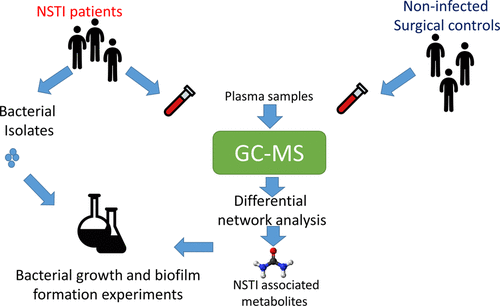当前位置:
X-MOL 学术
›
J. Proteome Res.
›
论文详情
Our official English website, www.x-mol.net, welcomes your feedback! (Note: you will need to create a separate account there.)
Integrated Univariate, Multivariate, and Correlation-Based Network Analyses Reveal Metabolite-Specific Effects on Bacterial Growth and Biofilm Formation in Necrotizing Soft Tissue Infections.
Journal of Proteome Research ( IF 4.4 ) Pub Date : 2020-01-14 , DOI: 10.1021/acs.jproteome.9b00565 Muhammad Afzal 1 , Edoardo Saccenti 2 , Martin Bruun Madsen 3 , Marco Bo Hansen 4 , Ole Hyldegaard 3 , Steinar Skrede 5, 6 , Vitor A P Martins Dos Santos 2 , Anna Norrby-Teglund 1 , Mattias Svensson 1
Journal of Proteome Research ( IF 4.4 ) Pub Date : 2020-01-14 , DOI: 10.1021/acs.jproteome.9b00565 Muhammad Afzal 1 , Edoardo Saccenti 2 , Martin Bruun Madsen 3 , Marco Bo Hansen 4 , Ole Hyldegaard 3 , Steinar Skrede 5, 6 , Vitor A P Martins Dos Santos 2 , Anna Norrby-Teglund 1 , Mattias Svensson 1
Affiliation

|
Necrotizing soft-tissue infections (NSTIs) have multiple causes, risk factors, anatomical locations, and pathogenic mechanisms. In patients with NSTI, circulating metabolites may serve as a substrate having impact on bacterial adaptation at the site of infection. Metabolic signatures associated with NSTI may reveal the potential to be useful as diagnostic and prognostic markers and novel targets for therapy. This study used untargeted metabolomics analyses of plasma from NSTI patients (n = 34) and healthy (noninfected) controls (n = 24) to identify the metabolic signatures and connectivity patterns among metabolites associated with NSTI. Metabolite-metabolite association networks were employed to compare the metabolic profiles of NSTI patients and noninfected surgical controls. Out of 97 metabolites detected, the abundance of 33 was significantly altered in NSTI patients. Analysis of metabolite-metabolite association networks showed a more densely connected network: specifically, 20 metabolites differentially connected between NSTI and controls. A selected set of significantly altered metabolites was tested in vitro to investigate potential influence on NSTI group A streptococcal strain growth and biofilm formation. Using chemically defined media supplemented with the selected metabolites, ornithine, ribose, urea, and glucuronic acid, revealed metabolite-specific effects on both bacterial growth and biofilm formation. This study identifies for the first time an NSTI-specific metabolic signature with implications for optimized diagnostics and therapies.
中文翻译:

集成的基于单变量,多元和相关性的网络分析揭示了坏死性软组织感染中代谢物对细菌生长和生物膜形成的特定作用。
坏死性软组织感染(NSTI)具有多种原因,危险因素,解剖位置和致病机制。在患有NSTI的患者中,循环代谢物可能会成为影响感染部位细菌适应性的底物。与NSTI相关的代谢特征可能显示出可用作诊断和预后标志物以及治疗新靶标的潜力。这项研究使用了来自NSTI患者(n = 34)和健康(未感染)对照(n = 24)血浆的非靶向代谢组学分析,以鉴定与NSTI相关的代谢物的代谢特征和连通性模式。代谢物-代谢物关联网络用于比较NSTI患者和未感染的手术对照组的代谢情况。在检测到的97种代谢产物中,NSTI患者中33的丰度发生了显着变化。代谢物-代谢物关联网络的分析显示,网络连接更加紧密:具体而言,NSTI与对照之间存在20种代谢物的差异连接。在体外测试了一组选定的显着改变的代谢产物,以研究其对NSTI A组链球菌菌株生长和生物膜形成的潜在影响。使用化学成分确定的培养基,添加选定的代谢物,鸟氨酸,核糖,尿素和葡萄糖醛酸,可以揭示代谢物对细菌生长和生物膜形成的特异性作用。这项研究首次确定了NSTI特异性代谢特征,对优化诊断和治疗具有重要意义。代谢物-代谢物关联网络的分析显示,网络连接更加紧密:具体而言,NSTI与对照之间存在20种代谢物的差异连接。在体外测试了一组选定的显着改变的代谢产物,以研究其对NSTI A组链球菌菌株生长和生物膜形成的潜在影响。使用化学成分确定的培养基,添加选定的代谢物,鸟氨酸,核糖,尿素和葡萄糖醛酸,可以揭示代谢物对细菌生长和生物膜形成的特异性作用。这项研究首次确定了NSTI特异性代谢特征,对优化诊断和治疗具有重要意义。代谢物-代谢物关联网络的分析显示,网络连接更紧密:具体而言,NSTI与对照之间存在20种代谢物的差异连接。在体外测试了一组选定的显着改变的代谢产物,以研究其对NSTI A组链球菌菌株生长和生物膜形成的潜在影响。使用化学成分确定的培养基补充了选定的代谢物,鸟氨酸,核糖,尿素和葡萄糖醛酸,可揭示代谢物对细菌生长和生物膜形成的特异性作用。这项研究首次确定了NSTI特异性代谢特征,对优化诊断和治疗具有重要意义。在体外测试了一组选定的显着改变的代谢产物,以研究其对NSTI A组链球菌菌株生长和生物膜形成的潜在影响。使用化学成分确定的培养基补充了选定的代谢物,鸟氨酸,核糖,尿素和葡萄糖醛酸,可揭示代谢物对细菌生长和生物膜形成的特异性作用。这项研究首次确定了NSTI特异性代谢特征,对优化诊断和治疗具有重要意义。在体外测试了一组选定的显着改变的代谢产物,以研究其对NSTI A组链球菌菌株生长和生物膜形成的潜在影响。使用化学成分确定的培养基,添加选定的代谢物,鸟氨酸,核糖,尿素和葡萄糖醛酸,可以揭示代谢物对细菌生长和生物膜形成的特异性作用。这项研究首次确定了NSTI特异性代谢特征,对优化诊断和治疗具有重要意义。
更新日期:2020-01-14
中文翻译:

集成的基于单变量,多元和相关性的网络分析揭示了坏死性软组织感染中代谢物对细菌生长和生物膜形成的特定作用。
坏死性软组织感染(NSTI)具有多种原因,危险因素,解剖位置和致病机制。在患有NSTI的患者中,循环代谢物可能会成为影响感染部位细菌适应性的底物。与NSTI相关的代谢特征可能显示出可用作诊断和预后标志物以及治疗新靶标的潜力。这项研究使用了来自NSTI患者(n = 34)和健康(未感染)对照(n = 24)血浆的非靶向代谢组学分析,以鉴定与NSTI相关的代谢物的代谢特征和连通性模式。代谢物-代谢物关联网络用于比较NSTI患者和未感染的手术对照组的代谢情况。在检测到的97种代谢产物中,NSTI患者中33的丰度发生了显着变化。代谢物-代谢物关联网络的分析显示,网络连接更加紧密:具体而言,NSTI与对照之间存在20种代谢物的差异连接。在体外测试了一组选定的显着改变的代谢产物,以研究其对NSTI A组链球菌菌株生长和生物膜形成的潜在影响。使用化学成分确定的培养基,添加选定的代谢物,鸟氨酸,核糖,尿素和葡萄糖醛酸,可以揭示代谢物对细菌生长和生物膜形成的特异性作用。这项研究首次确定了NSTI特异性代谢特征,对优化诊断和治疗具有重要意义。代谢物-代谢物关联网络的分析显示,网络连接更加紧密:具体而言,NSTI与对照之间存在20种代谢物的差异连接。在体外测试了一组选定的显着改变的代谢产物,以研究其对NSTI A组链球菌菌株生长和生物膜形成的潜在影响。使用化学成分确定的培养基,添加选定的代谢物,鸟氨酸,核糖,尿素和葡萄糖醛酸,可以揭示代谢物对细菌生长和生物膜形成的特异性作用。这项研究首次确定了NSTI特异性代谢特征,对优化诊断和治疗具有重要意义。代谢物-代谢物关联网络的分析显示,网络连接更紧密:具体而言,NSTI与对照之间存在20种代谢物的差异连接。在体外测试了一组选定的显着改变的代谢产物,以研究其对NSTI A组链球菌菌株生长和生物膜形成的潜在影响。使用化学成分确定的培养基补充了选定的代谢物,鸟氨酸,核糖,尿素和葡萄糖醛酸,可揭示代谢物对细菌生长和生物膜形成的特异性作用。这项研究首次确定了NSTI特异性代谢特征,对优化诊断和治疗具有重要意义。在体外测试了一组选定的显着改变的代谢产物,以研究其对NSTI A组链球菌菌株生长和生物膜形成的潜在影响。使用化学成分确定的培养基补充了选定的代谢物,鸟氨酸,核糖,尿素和葡萄糖醛酸,可揭示代谢物对细菌生长和生物膜形成的特异性作用。这项研究首次确定了NSTI特异性代谢特征,对优化诊断和治疗具有重要意义。在体外测试了一组选定的显着改变的代谢产物,以研究其对NSTI A组链球菌菌株生长和生物膜形成的潜在影响。使用化学成分确定的培养基,添加选定的代谢物,鸟氨酸,核糖,尿素和葡萄糖醛酸,可以揭示代谢物对细菌生长和生物膜形成的特异性作用。这项研究首次确定了NSTI特异性代谢特征,对优化诊断和治疗具有重要意义。



























 京公网安备 11010802027423号
京公网安备 11010802027423号